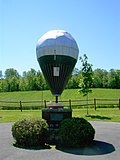This article includes a list of general references, but it lacks sufficient corresponding inline citations .(January 2020) |
| Double Eagle II | |
|---|---|
 The gas balloon Double Eagle II over Presque Isle, Maine attempting to cross the Atlantic | |
| General information | |
| Other name(s) | The Spirit of Albuquerque |
| Type | Helium balloon |
| Manufacturer | Ed Yost |
| Total hours | 137 hours 6 minutes |
| History | |
| Last flight | 11 August 1978 - 17 August 1978 |
| Preserved at | The gondola is displayed at the Steven F. Udvar-Hazy Center of the Smithsonian National Air and Space Museum annex at Washington Dulles International Airport in the Chantilly area of Fairfax County, Virginia, United States. |
| Fate | First balloon to cross the Atlantic Ocean |
Double Eagle II, piloted by Ben Abruzzo, Maxie Anderson and Larry Newman, became the first balloon to cross the Atlantic Ocean when it landed on 17 August 1978 in Miserey near Paris, 137 hours and 6 minutes after leaving Presque Isle, Maine. [1]
Contents
- Statistics
- Previous attempts
- Double Eagle
- Other attempts
- Successful subsequent flights
- References
- External links
It can be regarded as a successful crossing at the point that the Double Eagle II crossed the Irish coast, on the evening of 16 August, an event that Shannon Airport notified the crew about when it happened. Newman originally intended to hang glide from the balloon to a landing, while Anderson and Abruzzo continued to fly, but the hang-glider had to be dropped as ballast earlier on 16 August. While flying over France, they heard by radio that authorities had closed Le Bourget Airfield, where Charles Lindbergh had landed, for them. The crew declined the offer. They were running out of ballast and it would be too risky (to themselves and anyone below) to pass over the suburbs of Paris. They landed in a field of barley, owned by Roger and Rachel Coquerel, in Miserey, 60 mi (97 km) northwest of Paris. Television images showed a highway nearby, its shoulders and outer lanes crowded with stopped cars, people sweeping across the farm field to the landing spot. The gondola was protected, but most of the logs and charts were stolen by souvenir hunters.
The flight, the 14th known attempt at a transatlantic crossing by balloon, was the culmination of more than a century of previous attempts. Some of the people who had attempted it disappeared en route and were never found. Larry Newman won a draw among the three to sleep in the same bed at the United States Embassy that Lindbergh had slept in. British balloonists Don Cameron and Christopher Davey feted the trio at a party that included a balloon shaped like the Double Eagle II. The trio and their wives had made arrangements to return to the United States aboard the supersonic Concorde and, upon the successful crossing, their Concorde trip was accommodated by Air France at no charge to the trio and spouses.
A full chronicle of the voyage can be found in the December 1978 issue of National Geographic. Double Eagle II Airport in New Mexico is named for the balloon. The gondola is displayed at the Steven F. Udvar-Hazy Center of the Smithsonian National Air and Space Museum annex at Washington Dulles International Airport in the Chantilly area of Fairfax County, Virginia, United States. [2] A monument, containing a model of the balloon, was built to commemorate the Double Eagle II and its Atlantic crossing at the field from where the balloon lifted off [3] ( 46°37′36.54″N68°1′16.66″W / 46.6268167°N 68.0212944°W ).
In January 2015, the crew of the Two Eagles Balloon completed a flight across the Pacific Ocean. Their flight duration of 160 hours and 34 minutes record was verified by the Fédération Aéronautique Internationale, officially breaking the time-aloft record of the Double Eagle II. [4]


